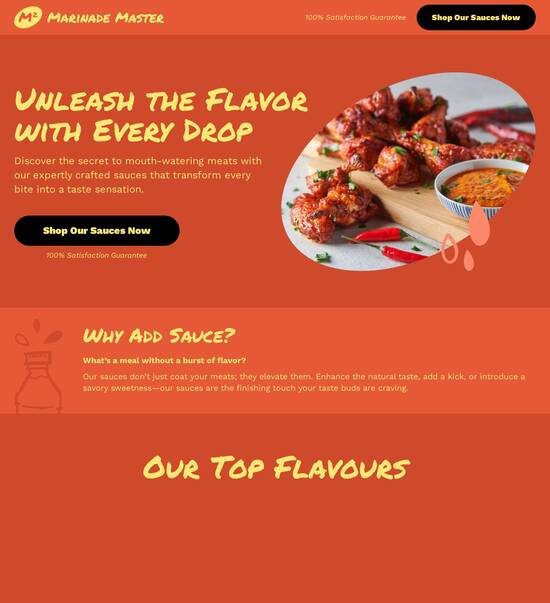
Retro HTML page templates
Use TemplateAbout template
Master the art of web design with retro HTML page templates. Transform your business today!
Recommended templates

Easy to build without coding
With the intuitive drag-and-drop builder, anyone on your team can create high-converting pages without any knowledge of code or design. Make enhancements to your landing page with custom widgets using Javascript, HTML/CSS, or third-party scripts.

Multiple layouts for any industry and goal
Select from 500+ landing page layouts built to boost conversions across industry-specific scenarios. Customize them by adjusting fonts, adding images, and generating on-brand content with the AI assistant. Quickly scale with Instablocks® and Global Blocks that you can save, reuse, and update globally.

Loads fast and looks polished on any device
Every template is responsive, which means they present professionally on any device and load blazingly fast with our Thor Render Engine. You can also power them up with Google AMP technology to deliver an unparalleled mobile experience and drive higher conversions.

Robust analytics & experimentation
Get real-time updates and reporting across all your devices, showing the number of visitors, conversions, cost-per-visitor, and cost-per-lead. Launch AI-powered experiments, run A/B tests, and use heatmaps to analyze user behavior, then optimize your landing page to maximize conversions.







Easy to build without coding
With the intuitive drag-and-drop builder, anyone on your team can create high-converting pages without any knowledge of code or design. Make enhancements to your landing page with custom widgets using Javascript, HTML/CSS, or third-party scripts.
Multiple layouts for any industry and goal
Select from 500+ landing page layouts built to boost conversions across industry-specific scenarios. Customize them by adjusting fonts, adding images, and generating on-brand content with the AI assistant. Quickly scale with Instablocks® and Global Blocks that you can save, reuse, and update globally.
Loads fast and looks polished on any device
Every template is responsive, which means they present professionally on any device and load blazingly fast with our Thor Render Engine.
Robust analytics & experimentation
Get real-time updates and reporting across all your devices, showing the number of visitors, conversions, cost-per-visitor, and cost-per-lead. Launch AI-powered experiments, run A/B tests, and use heatmaps to analyze user behavior, then optimize your landing page to maximize conversions.
All the features you need to build retro website templates
Explore more featuresLearn how to build retro landing page
Frequently asked questions about vintage website templates
Leading the way in building high-performing landing pages





Retro website template: Your ultimate how-to guide
Are you looking to supercharge your digital marketing strategy? Instapage is the ultimate solution for marketers aiming to craft high-converting landing pages and optimize their conversion rate. With its robust set of tools tailored to meet various business needs, Instapage empowers teams of all sizes to create, test, and improve their digital campaigns seamlessly.
Understanding Your Target Audience
Before diving into landing page creation, it’s essential to identify your specific audience. Instapage caters to diverse sectors such as business services, education, and financial services within the USA. Understanding the demographics, needs, and behaviors of these target markets will guide you in creating tailored content that resonates and converts.
- Identify key demographics: Understand who your audience is to target them effectively.
- Analyze their needs: Determine the pain points your landing pages should address.
- Craft personalized experiences: Use the insights gathered to create unique user journeys.
Utilizing Instapage Templates for Quick Launches
Instapage provides over 100 high-converting templates designed for success. Whether you're launching a campaign for a tech product or a government initiative, you can tailor these templates to suit your specific goals.
- Select a template that matches your campaign's purpose: Choose layouts that reflect your brand's message.
- Customize elements to engage your audience: Leverage intuitive builders to adjust text, images, and calls-to-action.
- Rapidly deploy your landing pages: Eliminate bottlenecks in the creation process and go live faster.
Optimizing Landing Pages for Better Conversions
Once your landing pages are live, it’s crucial to optimize them continuously. Instapage’s built-in experimentation features allow you to run A/B tests and analyze user behavior, ensuring your pages are always performing at their peak.
- Implement A/B testing: Experiment with different elements to see what resonates best with your audience.
- Use heatmaps to analyze on-page behavior: Identify where users engage most and refine your placement strategy.
- Review analytics regularly: Monitor your performance metrics and make data-backed adjustments.
By applying these strategies on Instapage, you’ll not only create visually appealing landing pages but also significantly improve your conversion rates.
In conclusion, Instapage offers an all-encompassing platform designed to meet your digital marketing needs. With tools that adapt to your evolving strategy, the potential for higher ROI is within reach.
Ready to transform your landing page strategy? Sign up for Instapage today and start optimizing your campaigns for success.
Retro HTML page template: A nostalgic throwback to early web design
Understanding the retro HTML page template concept
In the world of web design, the retro HTML page template offers a unique approach that harkens back to the early days of the internet. Defined by its nostalgic aesthetics and simplistic functionality, this type of template captures a sense of longing among users who experienced the early web. By weaving together vintage design elements, these templates become more than just a representation of old technology; they serve as a canvas through which brands can reconnect with their audience.
One of the most noticeable aspects of retro HTML designs is their nostalgic design elements. From bold colors to playful animations, these templates invite visitors to journey back to a time when the web was less refined and more about personal expression. Color palettes reminiscent of the early web design often feature bright tones and contrasting shades, while font choices reflect the trends of the 90s and early 2000s.
Nostalgic design elements that invoke familiarity.
Color palettes inspired by early web design aesthetics.
Fonts reminiscent of popular styles from the 90s and early 2000s.
The significance of retro in modern web design extends beyond mere visuals. Emotionally, these templates tap into users' nostalgia, creating a bond between the brand and its audience. This emotional connection can lead to increased engagement and loyalty, offering unique branding opportunities for businesses seeking to differentiate themselves in a crowded market.
Core features of retro HTML page templates
The core features of retro HTML page templates center around their structure, styling, and interactivity. When it comes to structure and layout, many retro templates utilize traditional table-based designs that were standard in the early internet. These fixed-width layouts contrast sharply with today’s responsive designs, which can lead to a distinctly old-school feel.
Styling techniques also play a crucial role in the effectiveness of these templates. Bold, vibrant background colors and playful patterns bring visual depth while incorporating GIFs and other animated elements keeps the design engaging. While using early CSS practices such as inline styles, many retro templates hearken back to a time when designers made the most of limited digital resources.
Traditional table-based layouts for a classic feel.
Fixed-width designs that add to the retro aesthetic.
Use of vibrant background colors and fun patterns.
Incorporation of GIFs and animated elements for a lively touch.
Early CSS practices that simplify design.
To enhance interactivity, many retro HTML templates integrate JavaScript functionality. Simple scripts can boost user engagement, with event listeners adding layers of dynamic behavior that invite users to interact with different elements on the page. For example, developers often use `document.addEventListener` to capture user actions, ensuring the website remains integral to the interactive experience.
Technical benefits of using retro HTML page templates
When selecting a retro HTML page template, you may find several technical benefits that make them a worthwhile choice. One notable advantage is their lightweight design, which typically results in faster loading times. Retro designs often favor minimalism, using fewer images and scripts, thus reducing the overall bloat that can slow down sites.
Cross-browser compatibility is another key feature of retro templates. As they often rely on simpler code structures, implementing support for older browsers becomes more manageable. This commitment to utility ensures that users accessing your content across different platforms enjoy a consistent experience.
Lightweight design that facilitates fast loading times.
Greater cross-browser compatibility through simpler code.
Easy to customize, with readily adjustable structures.
The ease of customization offered by retro HTML templates should not be overlooked. Due to their straightforward design structures, modifying CSS and HTML is often intuitive for developers of all skill levels. This accessibility encourages experimenting with styles, ensuring that brands can maintain their unique identity.
Creative applications for retro HTML page templates
The versatility of retro HTML page templates allows for diverse applications across various marketing spheres. Marketers can launch unique campaigns using retro designs to attract specific audiences seeking nostalgia. These templates can be particularly effective for product pages, where a retro twist can set the offering apart from competitors.
Additionally, personal and portfolio websites can benefit from a retro aesthetic. Creative professionals can showcase their work while tapping into trends from their formative years. By using interactive galleries or vintage-themed blogs, creatives can stimulate interest and connect with visitors on an emotional level.
Launching themed product pages that leverage nostalgia.
Creating unique portfolio sites that highlight individuality.
Designing event pages for celebrations or promotions.
Events and promotions also stand to benefit from retro HTML templates. For celebrations such as anniversaries or parties, a retro-themed page can capture the spirit of a bygone era, offering visitors an engaging experience. Furthermore, landing pages designed for retro-inspired music or art festivals can evoke a strong sense of nostalgia, enhancing the allure of the event.
Best practices for designing with retro HTML templates
When designing with retro HTML templates, one must strike a delicate balance between aesthetics and functionality. While a nostalgic design may appeal visually, it should not compromise mobile responsiveness—a critical factor in modern web design. Prioritizing user experience is imperative, ensuring that while the design reflects a playful past, it caters to today's user expectations.
Consistency in branding is another vital aspect to consider during the design process. Maintaining a cohesive visual language across all web pages will ensure that users clearly understand the brand's identity. Deliberate choices of design elements must reflect the messaging and goals of the brand, thereby creating a recognizable presence in the digital landscape.
Ensure mobile responsiveness while embracing retro aesthetics.
Maintain a cohesive visual language for brand consistency.
Test different retro designs to gauge user preferences.
Testing and optimization of retro designs is essential for refining user experience. By utilizing A/B testing, designers can determine which elements resonate best with users and optimize pages accordingly. Monitoring performance metrics through analytics tools will also provide essential data needed to assess the effectiveness of chosen designs.
Future trends in retro HTML template design
As retro HTML page templates continue to gain traction, embracing future trends is crucial for maintaining relevance. A notable trend is the merging of retro designs with modern usability principles. Integrating responsive components, while still paying homage to nostalgic elements, creates hybrid templates that resonate with a broader audience.
Furthermore, innovations in web technologies allows designers to leverage evolving standards in HTML and CSS to craft retro-inspired experiences. By tracking user engagement and preferences, brands can adapt their retro templates to stay in line with current trends while creating a vibrant digital presence.
Incorporating responsive features within a retro aesthetic.
Creating hybrid templates that blend old and new design principles.
Monitoring user engagement to refine retro inspirations.
Real-world examples of successful retro HTML deployments
There are several notable case studies that exemplify the successful implementation of retro HTML templates. Brands that have embraced these designs cater to audience desires for nostalgia, which can lead to memorable campaigns with higher engagement rates. For instance, some companies have launched effective marketing strategies by utilizing retro themes for limited-time promotions, directly resonating with consumers’ emotional connections to their past.
Analyzing these campaigns reveals valuable insights about audience engagement and the tangible impact on sales figures. Positive reviews and feedback from target users highlight heightened sentiments toward brands that evoke nostalgia, illustrating the power of retro design. These lessons can guide other brands in executing their own retro design initiatives, ensuring they tread the line between novelty and functionality.
Case studies of successful retro-themed campaigns.
Examining the impact on audience engagement and branding.
Identifying best practices from retrospective analysis.
Community and resources for retro design enthusiasts
The growing interest in retro design has given rise to various online communities that foster discussion and collaboration. These platforms include forums and social media groups dedicated to retro web design, providing insights into modern implementations and sharing resources. Engaging with these communities can help both professionals and amateurs stay updated on trends and innovations in retro design.
For those looking to enhance their skills, numerous workshops and tutorials on retro HTML template creation are readily available. These resources empower designers to experiment with vintage styles, while networking opportunities provide valuable connections within the design community.
Joining online forums focused on retro web aesthetics.
Attending workshops and tutorials for skills development.
Utilizing networking opportunities to connect with like-minded designers.
Ready to skyrocket conversions?
Supercharge your ad campaigns with high-performing landing pages
Get started














